Saturday 18th April 2020
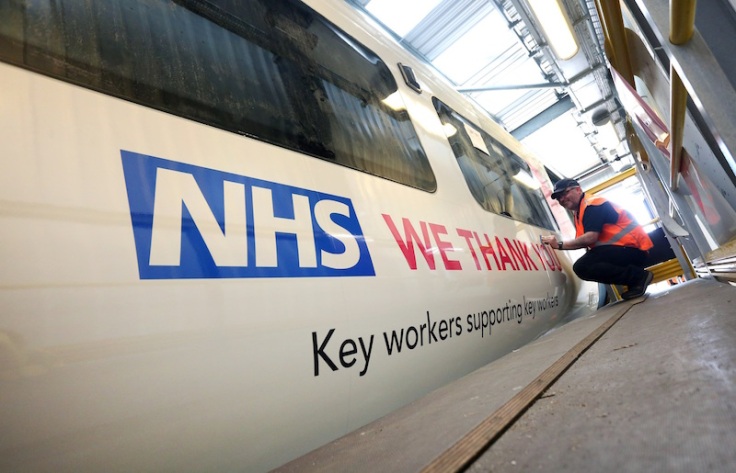
And so Lockdown Week 4 is nearly at an end and we’re still very much in the ‘who’d have thought it’ phase of Covid-19’s transport fallout. From free bus travel across most of London to committing billions on HS2; it’s been quite another week.
This coming Monday sees TfL’s finances take a further downward dive as it switches to free travel for most bus passengers across London. Who’d have thought that would happen just one month ago? It follows last week’s hastily arranged middle door boarding trial in response to drivers’ concerns at passengers coming too close to their screen protected cabs when boarding through the front door. No such reassurance for drivers on the 52 more minor bus routes operated by single front door only buses in London though, where passengers will still pass by drivers’ cabs just like happens everywhere else in the UK. But there’ll be no need to touch in on the ticket machine. Bus passenger numbers in London have reduced to 85% of normal times so many observe the revenue lost is not that great; but it’s still 15% of a large amount of dosh about to be forgone.
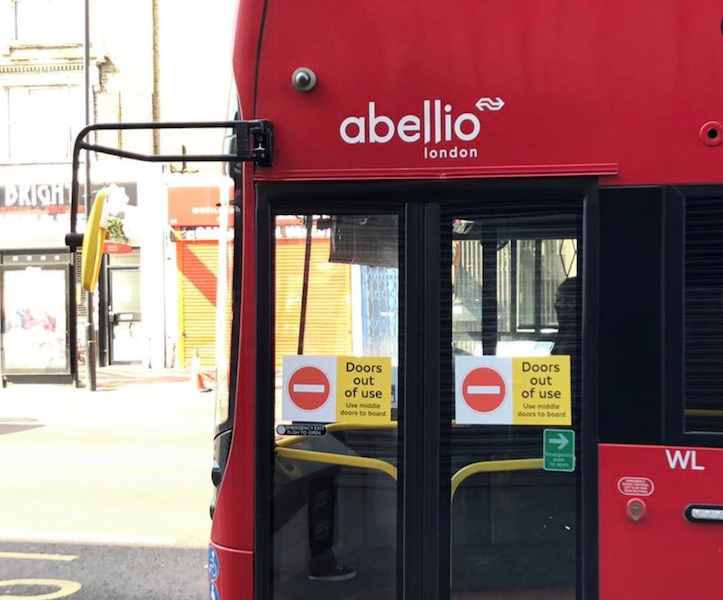
It’s not going to help the financial recovery in the Capital with TfL already struggling from four years of frozen fares and an ever delayed Crossrail. Neither is running bus routes at service levels well in excess of demand. Take one small example of this genre: Route 404 a backwater suburban round-the-houses route running between Caterham-on-the-Hill and Coulsdon.
Its half hourly ‘Saturday’ timetable is now operating all week, but that’s much the same as the half hourly Monday to Friday timetable anyway. Route 404 never used to operate on a Sunday until just before lockdown was announced on Monday 23rd March, TfL went ahead with its long planned minor change to part of the route together with the introduction of a new half hourly service all day Sundays from 06:27 to 19:44. Despite travel being restricted to essential purposes only, two buses have continued to run up and down the 37 minute route for the last four Sundays and will carry on doing so as lockdown continues, with I’m guessing, no passengers travelling on board at all. Still, at least drivers will feel protected and safe I suppose.

Other such anomalies can be found in provincial busland too; not least in Manchester where TfGM continues to enhance its reputation for shambolic rigidity and frustrating bus companies who see example after example of buses running where they’re simply not needed, not least school buses to schools which are closed or carrying a taxi load of a passenger. Manchester Community Transport (MCT Travel) and Jim Stones Coaches have both sadly ceased trading with consequential changes to many tendered bus routes organised by TfGM from this weekend, yet I’m told no details were available online even yesterday, Friday. Thankfully details are now posted on TfGM’s website, but as usual with these things, you have to know something is changing, unless you diligently and regularly click an online list of service changes as a lockdown pastime.
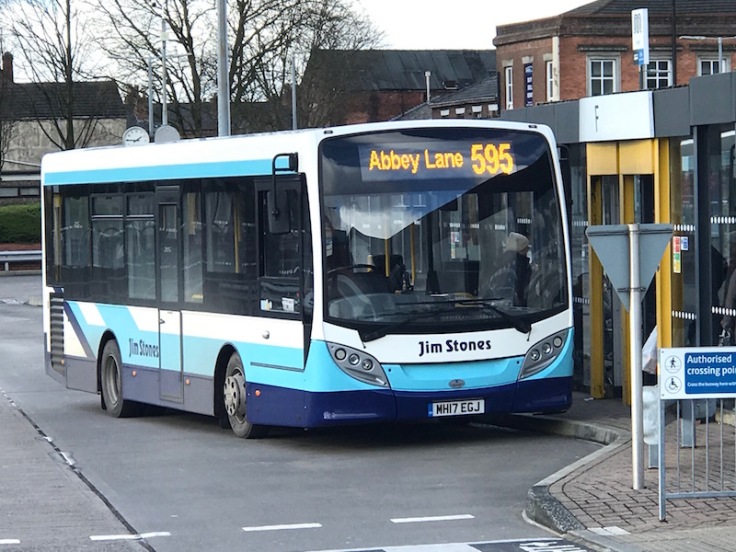
Meanwhile down in Cornwall where the County’s new ‘Superbus’ style Transport for Cornwall branded publicly funded network was introduced at the end of Lockdown Week 1, a correspondent commenting on last week’s Blogpost reports you can find “four buses linking closed tourist attractions in North Cornwall running from ten past eight in the morning to three minutes past nine in the evening; an hourly bus service between Looe and Polperro with one bus every two hours diverting via a closed camping site; buses to remote hamlets which have never previously enjoyed a Sunday service before last month while essential workers continue to complain at the continuing absence of early morning and evening buses to get them to and from work with care home workers particularly affected”.
I understand nobody has yet been furloughed in the rail industry. It must make social distancing in staff canteens and mess rooms a challenge as surely they must be pretty busy with less drivers and on board staff needed for the slimmed down timetables out on the tracks. I guess Government thinking is they’re paying for everything on the railway now anyway, so it’s not worth worrying about the 20% saving by reducing pay to a furloughed 80% pay rate. But those twenty percents would all add up; as would the savings achieved if the number of near empty trains were reduced to better match the 5% of passengers reportedly now travelling.
I love the idea that someone is tweeting for Grand Central Trains every day even though no trains are running. “Good morning, we’re here to help until 22:00” they duly tweet every morning at 06:00; and then bidding us all goodnight after a hard days non-tweeting at 22:00. Even better those tweets often gets three or four likes too!

It’s reported the rail industry is costing Government around £160 million a week; with TfL losing £100 million each week. Provincial buses are surviving on £14 million per week (plus the existing funding).
Whichever way you look at it, the commercial bus industry has really come into its own over the last few weeks showing enormous flexibility and responsiveness. Introducing flexible use of tickets across operators, concessionary passes before 09:30 and coordinated timetables are just some examples introduced at very short notice. A pragmatic deal was quickly reached with Government for financial support (Covid Bus Services Support Grant) even though they “will not be permitted to achieve an operational margin through CBSSG funding”. The £1 a km payment (actually to be precise, it’s £1.0051) is in return for companies operating ‘essential’ timetables at “up to 50%” of normal levels despite demand plummeting by at least 90%. In more normal times such a disparity between supply and demand would have meant instant service withdrawals but now it’s seen as a measure of success for key workers to be able to travel to work, whatever the cost. What a pity such an approach wasn’t around over the last few decades during the vicious spiral of retrenchment and decline. Still, better late than never, it’s really positive buses are being seen as a valued resource and their staff as key workers; and all at a very reasonable cost per mile compared to other mass movement modes.
Let’s hope this supportive attitude and financial grants towards buses will continue as the other existential threat facing the world – climate change – is slowly and steadily creeping up on us.
I took part in a fascinating “round table” (thanks Zoom) discussion with leading lights in the bus industry on Friday afternoon sharing ideas about the industry’s exit strategy from bus lockdown.

Much will depend on how return to normality is ramped up (to coin one of the many Covid-19 phrases we’re becoming accustomed to) as we’re all keen to see buses play a key role in our transport future. But there are understandable concerns that until mass Covid vaccination is available by mid 2021 (if we’re lucky) how the new social distancing norm will work in practice on board buses once the “avoid public transport at all costs” message is lifted and we are allowed gingerly back out to travel again for more than the essentials.
Sadiq Khan has been banging the drum these last few days for mask wearing as the way forward which isn’t surprising when you think how impractical it is to enforce a 2 metre rule on a peak time bus on route 24, never mind a Victoria Line Tube. Apparently Dublin Bus now reckon a double decker is full up with 18 people socially distancing on board. In the UK Stagecoach are having to lay on four socially distanced practising double decks on a journey taking workers to a food distribution plant in the Midlands whereas in pre Covid days one bus would have worked perfectly well for the numbers travelling. My colleagues tell me around 30 is about right for a social distanced double deck capacity – and that’s if you can persuade passengers to go upstairs, which apparently is not easy to do. The economics of running buses to such a business model is obviously flawed before they even leave the garage.
With schools likely to be among the first institutions returning to normal working post lockdown, their consequential need for buses will put a strain on peak hour resources with little compensating increase in the off-peak if concessionary pass holders are still required to continue watching Homes Under The Hammer instead of enjoying retirement making use of their bus pass. The economics of such an imbalanced network is also obviously flawed with no flattening of the bus graph curve.
So it’s not going to be an easy summer that’s for sure, and Government will need to make provision to pay the much welcomed Covid Bus Services Support Grant for many more months yet. “Turn-up-and-go” style frequencies are not returning any time soon; the passenger numbers just won’t be there to justify it. Sunday frequencies will be too little; Saturday frequencies too much. We’ll need Goldilocks style ‘Sunurday’ frequencies for a few months. It looks like much valued back room bus schedulers are going to be busy bees once again.

In other news this week the Confederation of Passenger Transport (CPT) has commendably launched its campaign to Back Britain’s Coaches. Coach operators up and down the country are on the edge of extinction as future business has all but collapsed. CPT points out coach tourism contributes over £6 billion to the economy each year so its unfortunate the Government has requested the Local Government Association withdraw the advice to operators to access support being offered to leisure businesses (rates relief and grants) as “they do not believe coach operators fall within the scope of the leisure definition”.
CPT is on the case and is encouraging coach operators to provide information on the financial impact the outbreak has had on their business so a case for specific support for the coach sector can be made. But, it’s concerning that as at Friday over 500 coach operator members of CPT have yet to respond to a simple request to provide key financial figures. It’s no good moaning about your business being under threat if you don’t help those trying to help you.
It’s not as if Government aren’t holding back on support and funding at the moment. I’m sure I’m not the only one to raise an eyebrow at Wednesday’s award of £3.3 billion worth of contracts to begin the first phase of HS2. Accompanying the announcement, the DfT published a revised business case for the project. But this was prepared before the Covid-19 pandemic which HS2 critics have been quick to point out will fundamentally alter UK travel demand. They may well have a point.
Finally for now, it’s a shame so few passengers will be able to see the appreciation being shown on train sides for our much loved and valued NHS now installed on a Thameslink and Southern train – appropriately enough units numbered 700111 and 377111 respectively. I wonder if this will start a trend.
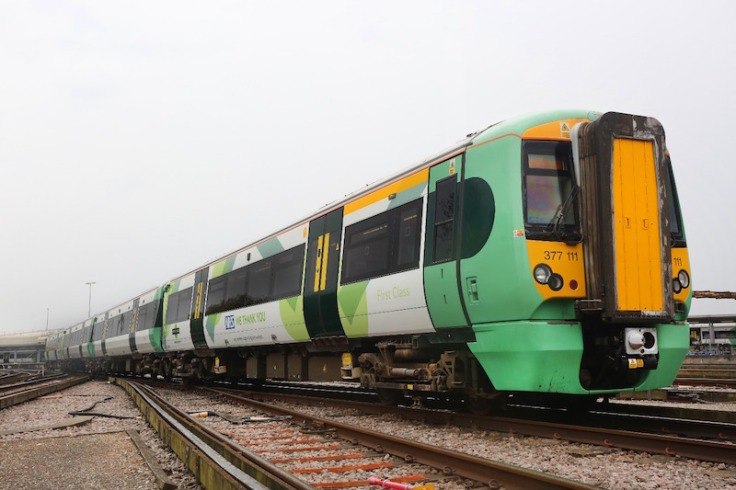
Roger French

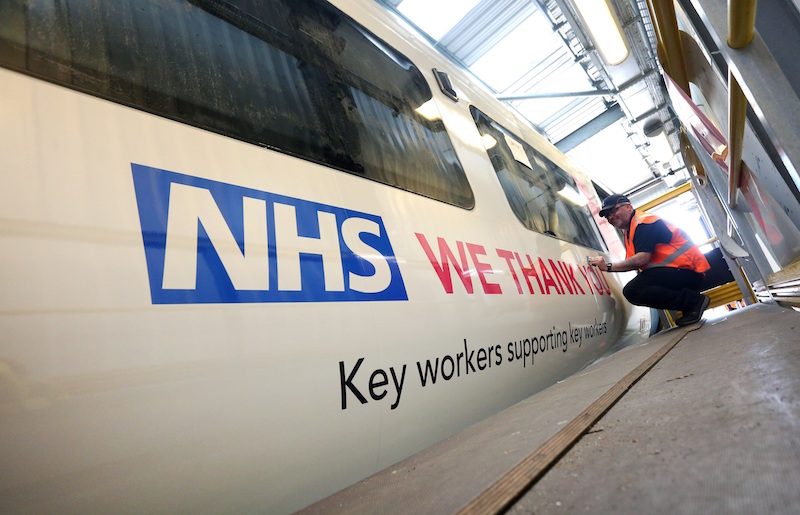
We have a wonderful anomaly in Glasgow. First has abandoned the village of Torrance during the day with the latest changes but the subsidised service is still running in the evening.
LikeLiked by 1 person
Regarding the postcode lottery for payment on single door TfL buses, I don’t know their source but the usually excellent twitter ‘London Bus Updates’ suggest that touch in will be disabled on Single Door buses as well to minimise contact time between driver and passenger:
LikeLiked by 1 person
Thanks Nick; have also just spotted that so have updated the blog. Many thanks.
LikeLiked by 1 person
I raised much more than an eyebrow when hearing, in the midst of what will undoubtedly become the worst financial crisis since the “South Sea Bubble” crash in 1720 (?), that HS2 was to proceed. I had naively thought the only two good things that may come out of this appalling health crisis was the obvious abandonment of HS2 and a severe reduction in air travel, the direct cause of the virus spreading so far and so fast. Apparently not.
LikeLiked by 1 person
The railway industry isn’t furloughing as such, but it’s more nuanced than that. For starters, a heck of a lot of ground-level uniformed staff are supplied by agencies rather than being TOC employees, and they’re simply not at work at the moment: the TOCs aren’t paying the agencies to supply them with staff, so the agencies aren’t supplying them. I suspect those staff aren’t furloughed; they’re simply unemployed.
Backroom staff, particularly managers, the HR and IT departments and the social media people are working from home as much as possible. Station staff and traincrew are working at reduced staffing levels with, generally, an understanding that staff who are not actually required for work on a given day staying at home; that means, for example, that station staffing levels are reduced, so anything up to 50% of station staff will be at home, while on the traincrew side there’s a roughly 33% reduction in number of running shifts being worked, with the staff whose shifts are cancelled staying at home, along with the vast majority of those who would be rostered spare [standby].
The name of the game on the railway in respect of staffing levels is enabling staff to socially distance from each other. Many staff messroom facilities, for example, have seat spacing little different to the average commuter train bays (albeit with tables!). Messroom capacity is therefore now a quarter or less of what it was pre-Covid, with staff levels (and shift lengths) being arranged to try to keep the number of staff in messrooms at any one time to an absolute minimum. It’s a struggle to provide sufficient safe space at many locations, though, so we’re seeing management offices and conference facilities being opened up as additional messroom space simply to try and keep us separated.
Most ground-level staff think we’re still running far too many trains (and also have far more staff around than are really needed), given the very low numbers of people travelling, especially off-peak, and it’s noticeable that a proportion of those passengers don’t exactly seem to be making essential journeys. Colleagues in the urban Midlands tell me that their most significant off-peak loading is the ‘usual suspects’ off to meet their dealers; perhaps going to buy class A drugs is deemed an essential journey.
LikeLiked by 1 person
Many thanks for this very interesting update.
LikeLike
Lots of thoughts worthy of a response here:
It’s become clear (and as we all expected) that leaving an “Authority” in charge of bus services at unusual times doesn’t work . . . . we have Cornwall; London and Manchester seemingly unable to respond quickly enough to new travel patterns. I wonder, if GoAhead were in charge of the network in Cornwall, whether we’d have seen more sensible revisions to the network.
Having said that, the new demand for bus services was impossible to predict, and there is a certain sense in implementing a reduction to a standard Saturday or Sunday timetable as being one that is already available (and remember that the TC’s have indicated that they would prefer this approach in their instructions for short-notice changes to timetables).
There is also the instruction from Whitehall that companies should provide around 40%-50% of services to qualify for BSSOG, so an 80%+ fall in passengers was always going to mean that supply would exceed demand..
In re schools routes . . . . if the school is open for key-workers children, then the bus should run, and who knew how many passengers there might be (and maybe not every day if the parent only works 4 days in 7; the child would only attend on 2-3 days each week).
My company operates two LTA contracts, and our instruction was to run the Saturday service . . . as these are one bus timetables, we can’t go much lower (no Sunday service is scheduled). Our two commercial routes were reduced to Saturday (two buses and drivers – no Sunday service); and Sunday times every day (three buses and five drivers) timetables; the daily route had extra NHS worker trips added before 0900 within 36 hours of a request from a key worker; we’d still probably be waiting for LTA permission if it was contracted!!
I see that the background rumblings are that schools may return in mid-May . . . . does that mean that exams can now be taken?!
That’ll mean another timetable re-write . . . . more late night working for the schedule compilers!!
And finally . . . . I enjoyed trying to name the faces in the Zoom screenshot . . . . although there seemed not to be any smiles!!!! I wonder why . . . . Material for another blog post shortly, Roger?
LikeLiked by 1 person
Excellent contribution; many thanks.
(Maybe not much to smile about on Zoom perhaps … it’s certainly interesting to see how minds wander during a meeting on Zoom!)
LikeLike
Re schools and exams, the government have cancelled the 2020 exam season, for everyone right through from Early Years up to A Level. They needed to give certainty early on, they couldn’t leave it as “You _might_ be taking exams in the summer or you might not, we can’t tell you until a few weeks beforehand”. For students who were due to take GCSEs and A Levels (or equivalent), they will be awarded nominal grades based on their mock exam results and moderated teacher assessments, with the option to sit the exam in the autumn term (assuming schools are back in session by then) if they are unhappy with the nominal grade they have been awarded. Pupils at primary school just won’t get an assessment.
LikeLike
A fair number of the buses were done yesterday at our garage so giving free rides a day early as such.
I’ve just done my first trip of the day and at 0430 I’m getting people banging on the front doors as to why I’m not letting them on even with the signage at eye level but I’d honestly expect nothing less!
Interestingly though we haven’t been told to record passenger numbers manually….
LikeLiked by 1 person
Living in north London without a car – same as 46% of London households probably a bit more here in Harringay – I think TfL have done a reasonable job in this crisis. We can walk to most places but it’s good to know they are there to get to bigger shops and the big hospital if needed. I commend their drivers. Service is of course fantastically punctual due to the lack of traffic – if only it were like this all the time. And the air is so clean ! But post crisis will be a massive challenge and will require huge public funding and local authority input. This would be great so long as the authority gains the expertise that has been lost in the past due to the current government not believing in planning of any kind. But in my opinion the market doesn’t do public transport well. It is an essential service not just for non car owning key workers – who were thought of rather more disparagingly before the current mess – but for a sustainable transport future. We’ll see. My guess it is about 50/50 whether public transport comes out of this looking forward to a better future or disaster beckons.
LikeLiked by 1 person
And so it begins: “London’s transport authority could run out of money to pay staff by the end of the month unless the government steps in, Sadiq Khan has warned”.
https://www.bbc.co.uk/news/uk-england-london-52379111
LikeLiked by 1 person
I dunno, maybe it’s me but….
If people who work and serve in shops and supermarkets are able to serve people directly and from behind screens, including handling cash, and bus drivers all over the U.K. are also able to manage the same similarly, but WITHOUT the benefit of screens in most cases, then why is this such an issue for bus drivers in LONDON?
Not even have they re-instated the oyster readers that are in existence at the other doors on all the boris-buses, and requested passengers adopt the honesty system that those same buses used full time up until recently.. no it’s just a total free for all!
I’m now looking forward to Sainsbury’s and ASDA etc offering help yourself groceries, in order to protect staff working at their checkouts, though probably only in the London area of course, or is it just a case of Sadiq being happy to be generous with money that he hopes to not have to be responsible for finding…. again….
LikeLiked by 1 person